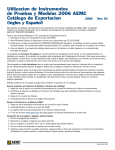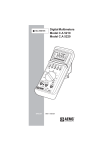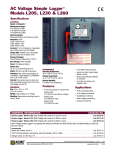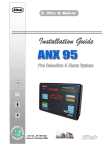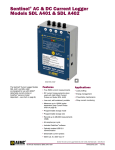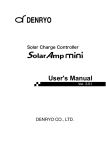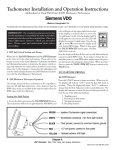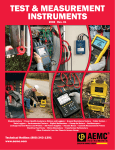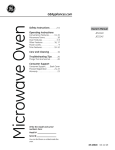Download MODEL MX54 - Chauvin Arnoux Group
Transcript
PORTABLE DIGITAL MULTIMETER
MODEL MX54III
USER MANUAL
®
INSTRUMENTS
&KDSWHU ,
86(5
6 0$18$/ &217(176
1. GENERAL INSTRUCTIONS .................................................................................................................................. 1
1.1. Precautions and safety measures................................................................................................................... 1
1.1.1. Before use................................................................................................................................................ 1
1.1.2. During use................................................................................................................................................ 1
1.1.3. Symbols ................................................................................................................................................... 2
1.1.4. Opening the instrument............................................................................................................................ 2
1.2. Protection devices........................................................................................................................................... 2
1.3. Safety devices................................................................................................................................................. 3
1.4. Warranty ......................................................................................................................................................... 3
1.5. Maintenance and metrological verification ...................................................................................................... 3
1.6. Unpacking - Repacking ................................................................................................................................... 3
2. DESCRIPTION....................................................................................................................................................... 4
2.1. Selector switch ................................................................................................................................................ 4
2.2. Keypad ............................................................................................................................................................ 4
2.3. Display ............................................................................................................................................................ 4
2.4. Power supply................................................................................................................................................... 4
2.5. Input terminals................................................................................................................................................. 4
3. COMMISSIONING ................................................................................................................................................. 5
3.1. Connecting the test leads................................................................................................................................ 5
3.2. Switching on the instrument ............................................................................................................................ 5
3.3. Switching off the instrument ............................................................................................................................ 5
3.4. Special configurations..................................................................................................................................... 5
3.5. Multimeter maintenance .................................................................................................................................. 6
3.5.1. Fuse self-test ........................................................................................................................................... 6
3.5.2. Battery self-test ........................................................................................................................................ 6
3.5.3. Replacing the battery or fuses ................................................................................................................. 6
3.5.4. Cleaning................................................................................................................................................... 6
4. FUNCTIONAL DESCRIPTION............................................................................................................................... 7
4.1. SEL/ON key ................................................................................................................................................... 7
4.1.1. VAC position .............................................................................................................................................. 7
4.1.2. mV position .............................................................................................................................................. 7
4.1.3. VDC position .............................................................................................................................................. 8
4.1.4. Ω position................................................................................................................................................. 8
position ................................................................................................................................................ 8
4.1.5.
4.1.6. µA mA / 10 A positions ............................................................................................................................ 9
4.1.7. °C Position ............................................................................................................................................... 9
4.2. RANGE key................................................................................................................................................... 10
4.3. REL key......................................................................................................................................................... 10
4.4. Pk +/- key ...................................................................................................................................................... 10
4.5. HOLD key...................................................................................................................................................... 10
4.6. ZOOM key ..................................................................................................................................................... 10
4.7. SURV key...................................................................................................................................................... 11
4.8. Hz key ........................................................................................................................................................... 11
4.9. PRINT key..................................................................................................................................................... 11
key ........................................................................................................................................................ 11
4.10.
5. TECHNICAL SPECIFICATIONS.......................................................................................................................... 12
5.1. DC voltages................................................................................................................................................... 12
5.2. AC voltages (AC and AC+DC) ...................................................................................................................... 12
5.3. DC current..................................................................................................................................................... 13
5.4. AC currents (AC and AC+DC)....................................................................................................................... 13
5.5. Resistance / Continuity ................................................................................................................................. 14
5.6. Capacitance .................................................................................................................................................. 14
5.7. Diode threshold voltage measurement ......................................................................................................... 15
5.8. Frequencies .................................................................................................................................................. 15
5.9. Duty cycle %+, %- ......................................................................................................................................... 15
5.10. Temperature function .................................................................................................................................. 16
5.11. dB function .................................................................................................................................................. 16
5.12. Analysis of noise on the 50/60 Hz mains .................................................................................................... 16
6. GENERAL SPECIFICATIONS............................................................................................................................. 17
3RUWDEOH GLJLWDO PXOWLPHWHU
&KDSWHU ,
*(1(5$/ ,16758&7,216
You have just acquired a portable digital multimeter and we thank you for your purchase.
This instrument complies with the specification of IEC publication 1010-1, concerning safety
requirements for electronic measuring apparatus. To get the best service from this
instrument, read carefully this user's manual and respect the detailed safety precautions.
1.1.
Precautions and safety measures
1.1.1. Before use
- This device can be used for measurements on category ΙΙΙ installations, pollution
rating 2, for voltages never exceeding 600 V (AC or DC) relative to the earth.
- Definition of overvoltage categories (cf. publication IEC 664-1) :
CAT I :
The circuits of CAT I are protected by measures limiting transient
overvoltages to appropriate low level.
Example : protected electronic circuits
CAT II :
The circuits of CAT II are power supply circuits of appliances or portable
equipment with transient overvoltages of an average level.
Example : appliances and portable equipment
CAT III : The circuits of CAT III are power supply circuits of power equipment with
important transient overvoltages.
Example : fixed installation or industrial equipment
CAT IV : The circuits of CAT IV may comprise very important transient
overvoltages.
Example : primary supply level
∗ For your own safety, only use the measuring probes which have been delivered with
the instrument : they conform to the IEC 1010-1 safety standard. Before use, check
that they are in good condition.
1.1.2. During use
∗ Test equipment risk assessment : Users of this equipment and or their employers
are reminded that Health and Safety Legislation require them to carry out a valid
risk assessment of all electrical work so as to identify potential sources of
electrical danger and risk of electrical injury such as from inadvertent short
circuits. Where the assessment show that the risk is significant then the use of
fused test leads constructed in accordance with the HSE guidance note GS38
"Electrical Test Equipment for use by Electricians" should be used.
∗ Never exceed the protection limit values indicated in the specifications for each type
of measurement.
∗ When the multimeter is connected to energized circuits, do not touch unused
terminals.
3RUWDEOH GLJLWDO PXOWLPHWHU
&KDSWHU ,
∗ When the scale of the value to be measured is unknown, check that the scale
initially set on the multimeter is the highest possible or, wherever possible, choose
the autoranging mode.
∗ Before changing functions, disconnect the test leads from the circuit under test.
∗ When performing current measurements, do not connect or disconnect leads
without first isolating the current. If you do, there is a risk of generating surge
currents which can blow the fuses or damage the instrument.
∗ In TV repair work, or when carrying out measurements on power switching circuits,
remember that high amplitude voltage pulses at the test points can damage the
multimeter. Use of a TV filter will attenuate any such pulses.
∗ Never perform resistance measurements on live circuits.
6\PEROV
W arning : Refer to the user's m anual.
Da ng e r, h ig h v oltage : R isk of elec tric sh oc k
E arth term ina l
2SHQLQJ WKH LQVWUXPHQW
∗ Before opening the instrument, always disconnect from all sources of electric
current and make sure not to be loaded with static electricity, which may destroy
internal components.
∗ Fuses must be replaced with fuses of the same rating and type.
∗ Any adjustment, maintenance or repair work carried out on the multimeter while it
is live should be carried out only by appropriately qualified personnel, after
having taken into account the instructions in this present manual. A "qualified
person" is one who is familiar with the installation, construction and operation of
the equipment and the hazards involved. He is trained and authorized to
energize, de-energize circuits and equipment in accordance with established
practices
∗ When the instrument is open, for maintenance purposes for example, remember
that some internal capacitors can retain a dangerous potential even after the
instrument is powered down.
∗ If any faults or abnormalities are observed, take the instrument out of service and
ensure that it cannot be used until it has been checked out.
∗ It is recommended to remove the battery from the instrument if not used.
1.2.
Protection devices
ASYC II series instruments are fitted with various protection devices :
3RUWDEOH GLJLWDO PXOWLPHWHU
&KDSWHU ,
∗ Varistor protection for limiting transients of over 1100 V at the VΩ terminal,
particularly 6 kV pulse streams as defined in French standard NFC 41-102.
∗ A PTC (Positive Temperature Coefficient) resistor protects against permanent
overvoltages of up to 600 V during resistance, capacitance and diode test
measurements. This protection is reset automatically after overload.
∗ Two fuses provide protection during measurements of intensity type.
∗ Maximum protection between mA and 10 A input terminals : 500 V.
∗ An IP protection rating of 67.
1.3.
Safety devices
∗ The battery unit and fuses cannot be accessed without first disconnecting the
measuring leads.
∗ When measuring voltages above 24 V, the sign blinks
[ on the display.
∗ If the maximum range is repeatedly exceeded, an intermittent audible signal indicates
the risk of electric shock.
:DUUDQW\
This equipment is warranted against any defects of manufacture or materials according to
the general conditions of sale.
During the warranty period (3 years), defective parts will be replaced, the manufacturer
reserving the right to repair or replace the product. In the event of the equipment being
returned to the after sale department or to a local agency, carriage to the centre shall be
payable by the customer.
0DLQWHQDQFH DQG PHWURORJLFDO YHULILFDWLRQ
8QSDFNLQJ 5HSDFNLQJ
5HWXUQ \RXU LQVWUXPHQW WR \RXU GLVWULEXWRU IRU DQ\ ZRUN WR EH GRQH ZLWKLQ RU RXWVLGH WKH
JXDUDQWHH
This equipment has been fully checked out mechanically and electrically before shipping.
All precautions have been taken to ensure that the instrument arrives at its destination
undamaged.
However, it is advisable to carry out a rapid check for damage sustained in shipping.
If there is any evidence of damage, make this known immediately to the shipper.
*
)
Caution
Note
Should you need to return the instrument, preferably use the original
packaging and indicate the reasons as clearly as possible on an
accompanying note.
Our products are patented in FRANCE and ABROAD. The logotypes
are registered.
The manufacturer reserves the right to modify specifications and prices
as required by technological improvements.
3RUWDEOH GLJLWDO PXOWLPHWHU
&KDSWHU ,
2.
DESCRIPTION
This multimeter is one of the ASYC II (Advanced Safety Concept, second generation) family,
designed for a high degree of user safety, maximum protection and a hitherto unrivalled
performance.
2.1.
Selector switch
It is a standalone, handheld professional measuring instrument, capable of measuring the
following quantities (accessed by the ten-position rotary selector switch) :
∗
∗
∗
∗
∗
∗
∗
∗
∗
∗
∗
∗
∗
∗
∗
2.2.
AC voltages with AC (or RMS) capacitive coupling,
AC voltages with AC+DC (or TRMS) direct coupling,
DC voltages,
AC currents with AC (or RMS) capacitive coupling,
AC currents with AC+DC (or TRMS) direct coupling,
DC currents,
resistance values,
continuity (with beeper),
capacitance,
diode threshold voltage,
frequencies,
duty cycles,
dBm,
noise on the 50/60 Hz mains supply,
temperature.
Keypad
An ten-key keypad lets you :
∗
∗
∗
∗
∗
∗
∗
∗
∗
∗
2.3.
select the autoranging mode (RANGE key)
store a value (HOLD key)
measure fast peaks (Pk +/- key)
set the measurement relative to a reference value (REL key)
select a function derived from the main function, or switch on the multimeter again after it
has been shut down automatically (SEL/ON key)
select time-domain measurements: frequency, duty cycle, (Hz key)
select survey mode to detect minimum, maximum or average value (SURV key)
expand the bargraph scale (ZOOM key)
activate sending data to a printer (PRINT key)
activate back lighting of the display unit (
key)
Display
The display shows :
∗ clearly legible figures (14 mm high)
∗ a readout of the parameter being measured through a 34-segment bargraph
∗ perform 50 000-point measurements (high resolution)
∗ perform 5 000-point measurements (low resolution)
Display backlight when required in poor lighting conditions. Automatic switch off.
2.4.
Power supply
It is powered by a standard 9 V battery which provides approximately 500 hours of operation.
2.5.
Input terminals
Measurements are performed using two measuring leads supplied with the instrument connected
to input terminals 1, 2, 3 and 4, as indicated in § 3.1.
3RUWDEOH GLJLWDO PXOWLPHWHU
&KDSWHU ,
3.
COMMISSIONING
3.1.
Connecting the test leads
Connect the black lead to the COM socket (for all measurements). Depending on the
position of the selector switch, connect the red lead as follows:
3.2.
Rotary selector switch position
Input terminal
VAC, mVDC, VDC, Ω,
VΩ
, °C
10 A
A
µA mA
µA mA
Switching on the instrument
Turn the selector switch to the required function.
All segments of the display come on for a few seconds. The instrument is then ready for
measurements.
3.3.
Switching off the instrument
The instrument can be switched off manually by returning the selector switch to the OFF
position, or automatically after approximately half an hour if no key is pressed or the switch
is not operated.
)
Note
Automatic shutdown of the instrument is disabled in order to avoid
interrupting the surveillance mode (SURV), peak measurements (Pk +/-) or
a data print-out.
For user safety, automatic shutdown is also disabled when a measured
magnitude (Voltage/current) present at the input exceeds dangerous levels
(
3.4.
indicator displayed).
Special configurations
To adapt the configuration of the instrument to the measurement environment, the user
can :
- Choose 50 Hz or 60 Hz rejection :
Switch on with the rotary switch while holding down the HOLD key. The selection is
reversed from the last configuration, is displayed for two seconds and remains backed
up in non-volatile memory.
- Choose the input impedance for measurements in the mV range :
Switch on with the rotary switch while holding down the RANGE key. The selection is
reversed from the last configuration, is displayed for two seconds, and remains backed
up in non-volatile memory.
- Choose a low resolution mode (5 000 points) :
Switch on with the rotary switch while holding down the REL key. The selection is
displayed for two seconds.
3RUWDEOH GLJLWDO PXOWLPHWHU
&KDSWHU ,
3.5.
Multimeter maintenance
3.5.1. Fuse self-test
When fuse F1 (0.63 A) or F2 (10 A) is blown, the display shows “FUSE.1” or “FUSE.2”,
accordingly.
If both fuses are blown, the display shows “FUSES”.
Replace the fuse or fuses concerned.
)
Note
Fuse F1 cannot be tested unless the switch is set to the µA mA position.
Fuse F2 is located in the common circuit. Therefore, V, Ω, C and
measurements in the 10 A range, become impossible when it is out of
service.
3.5.2. Battery self-test
When the BAT indication appears on the display, the instrument still has approximately 50
hours of operation, but specifications can no longer be guaranteed.
Replace the battery.
3.5.3. Replacing the battery or fuses
Open the multimeter casing as follows (refer to last page of the manual) :
1 - Remove the stand from the back of the instrument.
Figures 2 and 3
2 - Remove the SECUR’X cover using the stand.
Figure 4
3 - Remove the front cover using the stand as a lever.
Figure 5
4 - Remove the gasket.
5 - Replace the battery or fuse.
Before use, make sure that the gasket, then the front cover are carefully set back on the
instrument.
&OHDQLQJ
&OHDQ WKH PXOWLPHWHU XVLQJ D GDPS FORWK 'R QRW XVH DEUDVLYHV RU VROYHQWV
3RUWDEOH GLJLWDO PXOWLPHWHU
&KDSWHU ,
4.
FUNCTIONAL DESCRIPTION
4.1.
SEL/ON key
This can be used to switch on the multimeter again after an automatic shutdown. It can also
be used to access secondary functions associated with the selector switch positions.
The flowcharts below define these various functions.
4.1.1. VAC position
$& YROWDJH PHDVXUHPHQWV
6(/21
G%P PHDVXUHPHQW
6(/21
$QDO\VLV RI PDLQV QRLVH
6(/21
4.1.2. mV position
'& YROWDJH PHDVXUHPHQW
P9 UDQJH
6(/21
$&'& YROWDJH PHDVXUHPHQW
P9 UDQJH
6(/21
3RUWDEOH GLJLWDO PXOWLPHWHU
&KDSWHU ,
4.1.3.
VDC position
'& 9ROWDJH PHDVXUHPHQW
6(/21
$&'& 9ROWDJH PHDVXUHPHQW
6(/21
4.1.4. Ω position
5HVLVWDQFH PHDVXUHPHQW
6(/21
&RQWLQXLW\ WHVW
6(/21
4.1.5.
position
&DSDFLWDQFH PHDVXUHPHQW
6(/21
'LRGH YROWDJH PHDVXUHPHQW
6(/21
3RUWDEOH GLJLWDO PXOWLPHWHU
&KDSWHU ,
4.1.6. µA mA / 10 A positions
'& FXUUHQW PHDVXUHPHQW
6(/21
$& FXUUHQW PHDVXUHPHQW
6(/21
$&'& FXUUHQW PHDVXUHPHQW
6(/21
4.1.7. °C Position
7HPSHUDWXUH PHDVXUHPHQW
6(/21 ! VHF
6(/21 VHF
&RQQHFWLRQV VKRUW
FLUFXLWHG
6HQVRU VHOHFWLRQ
3W 3W 6FDOH VHOHFWLRQ
Ü&Ü)
5(/
7HPSHUDWXUH PHDVXUHPHQW
ZLWK FRQQHFWLRQ UHVLVWDQFH
FRPSHQVDWLRQ
°C/°F selection and Pt 100 / Pt 1000 selection are saved in non-volatile memory.
Pt 100 selection is indicated by display of Ω symbol and Pt 1000 by display of kΩ symbol.
3RUWDEOH GLJLWDO PXOWLPHWHU
&KDSWHU ,
4.2.
RANGE key
• AUTO mode to switch to MANUAL mode (short press).
• MANUAL mode, to select the next range (short press) or return to AUTO mode (long
press).
Measurements concerned : voltages (except 500 mV range), capacitance, resistance,
current (except 10 A range).
• When making time measurement (frequency, duty cycle) : if the range change made
during previous measurements (Voltage or Current) was in manual mode, it may be
necessary to adapt this measurement range to the signal level injected at the input. This
is why the RANGE key is used to change from one range (Voltage or Current) to the
next range. The new range is then displayed for 2 seconds.
4.3.
REL key
Short press : REL mode, the last value measured becomes the reference value derived
from subsequent measurements. In temperature measurement the REL key
used to compensate the connexions resistance (refer to § 4.1.7.).
Long press :
4.4.
When in REL mode, a long press displays the reference being used. This
value may be adjusted using the SEL/ON key (selection of digits and a
sign) and the RANGE key (increment the selected digit).
Pk +/- key
The fast positive or negative peak measurement functions ( ≥ 1 msec.) can be accessed by
repeatedly pressing this key in the VDC, mVDC, mADC and 10 A DC functions.
4.5.
HOLD key
Short press :
Fixes the display on the current value.
Long press :
Accesses or quits the “autostore” mode. Can be accessed in the VDC, mV,
VAC positions.
Autostore
Set the probes on the point to be measured. An audio signal indicates if the measurement is
stable. When you remove the probes, a second audible signal indicates that this stable
value displayed has been stored.
4.6.
ZOOM key
You can press this key to expand the bargraph readout five times for positive measurements
and eleven times for bipolar measurements, one centred around zero (centre zero mode).
Adjusts ohm-value references in dB and audio power measurements.
When the current measurement is dB or audio power, you can display the resistance
reference with the ZOOM key (long press). This value can then be adjusted using the
SEL/ON and RANGE keys. You quit the ohm reference adjustment mode with the ZOOM
key (short press).
3RUWDEOH GLJLWDO PXOWLPHWHU
&KDSWHU ,
4.7.
SURV key
If you press this key (long press), you access the surveillance mode (or coming out), in
which minimum (MIN), maximum (MAX) and sliding average (AVG) values of the current
measurement are stored.
You can look up each of these values by repeatedly pressing the same key (short press).
The symbols MIN, MAX or AVG flicker with the selected value.
)
Note
4.8.
Hz key
When entering in the SURV mode, non-coherent values may be displayed.
When the current positions are VAC, VDC, mV, mA and 10 A, the Hz key invokes, in turn :
- frequency measurement,
- positive duty cycle measurement (% +) and negative one (% -).
A long press on Hz key allows a direct selection of the voltage or current function.
35,17 NH\
This key operates with optional interface accessory for printer or PC.
Short press :
activates / deactivates «send measures to printer» mode at the rate
defined by the user.
Long press :
adjusts the rate varying from 00000 sec (a single transmission) up to 9h
59 min. 59 sec, using the SEL/ON key (selection of digits) and the range
key (increment the selected digit).
NH\
Activates / deactivates back lighting of the display unit.
It automatically goes off after about 30 seconds.
3RUWDEOH GLJLWDO PXOWLPHWHU
&KDSWHU ,
5.
TECHNICAL SPECIFICATIONS
Only those values assigned tolerances or limits are guaranteed values. Values without
tolerances are given for information only (French standard NF C 42-670).
{Accuracy : ‘’n% R + nD’’ means ‘’n% of the reading + n digits’’ as per IEC 485}
5.1.
DC voltages
6HOHFWRU
VZLWFK SRVLWLRQ
P9
9'&
* refer to § 3.4.
5DQJHV
P9
9
9
9
9
,QSXW
$FFXUDF\ LPSHGDQFH
3URWHFWLRQ
5 ' 0Ω*Ω Û 93. 5 ' 0Ω
Û 93.
5 ' 0Ω
Û 93.
5 ' 0Ω
Û 93.
5 ' 0Ω
Û 93.
5HVROXWLRQ
Ú9
Ú9
P9
P9
P9
** 1 mn max
Number of points :
50 000 (or 5 000, refer to § 3.4)
Range selection :
automatic or manual for the 5 V, 50 V, 500 V, 1000 V ranges
Common mode rejection : at 50 and 60 Hz, better than 120 dB
Serial mode rejection :
at 50 and 60 Hz, better than 60 dB
Additional error in Pk +/- mode for a pulse of > 1 ms : 1% R ± 50 D
5.2.
AC voltages (AC and AC+DC)
6HOHFWRU
VZLWFK
SRVLWLRQ
P9 6(/21
9$& RU
9'& 6(/21
5DQJHV
$FFXUDF\
,QSXW
LPSHGDQFH
+] N+] WR N+] WR N+] WR N+] WR
WR N+] N+] N+]
N+]
N+]
IURP WR RI UDQJH
IURP WR RI UDQJH
P9
5
0Ω*Ω S)
'
9
0Ω
S)
9
5 ' 5
5 '
5
0Ω
S)
'
'
9
0Ω
S)
9
0Ω
S)
3URWHFWLRQ
5HVR
OXWLRQ
Û93.
Û 93.
Û 93.
Û 93.
Û 93.
Ú9
'&
* AC+DC only.
** refer to § 3.4.
Ú9
P9
P9
P9
*** 1 mn max
Number of points :
50 000 (or 5 000, refer to § 3.4)
Range selection :
automatic or manual for the 5 V, 50 V, 500 V, 750 V ranges
Common mode rejection :
at 50 and 60 Hz, better than 80 dB
Additional error according to crest factor :
0.2 % for a crest factor of 2 to 3
0.5 % for a crest factor of 3 to 6
(Specification given full scale for a squarewave signal pulse 200 µs wide)
3RUWDEOH GLJLWDO PXOWLPHWHU
&KDSWHU ,
Curve showing typical measurement error (5 V, 50 V, 500 V ranges)
Vin = 100 % F.S.
50000 pts
Vin = 50 % F.S.
25000 pts
7500 pts
Vin = 15 % F.S.
1%
2%
5%
10%
Vin = 5 % F.S.
2500 pts
1000 pts
1 kHz
5.3.
100 kHz
10 kHz
DC current
6HOHFWRU
VZLWFK
SRVLWLRQ
Ú$ P$
$
5DQJHV
$FFXUDF\
Ú$
P$
P$
P$
$
5 '
5 '
5 '
5 '
5 '
0D[
YROWDJH
GURS
P9
P9
P9
9
P9
3URWHFWLRQ
)XVHV
5HVROXWLRQ
9506
9506
9506
9506
9506
) )
) )
) )
) )
)
Q$
Q$
Ú$
Ú$
P$
* refer to fuse specifications, § 6.1.1.
Number of points :
50 000 (or 5 000, refer to § 3.4)
Range selection :
automatic or manual for the 500 µA, 5 mA, 50 mA, 500 mA ranges
Additional error in Pk +/- mode for a pulse width of > 1 ms : 1% R ± 50 D
5.4.
AC currents (AC and AC+DC)
5DQJHV
Ú$
P$
P$
P$
$
$FFXUDF\
+] WR N+]
WR RI UDQJH
5 '
5 '
'& 5 '
5 ' XS WR N+]
* refer to fuse specifications, § 6.1.1.
3RUWDEOH GLJLWDO PXOWLPHWHU
3URWHFWLRQ
9506
9506
9506
9506
9506
)XVHV
) )
) )
) )
) )
)
**AC + DC only
5HVROXWLRQ
Q$
Q$
Ú$
Ú$
P$
&KDSWHU ,
Number of points :
50 000 (or 5 000, refer to § 3.4.)
Range selection :
automatic or manual for the 500 µA, 5 mA, 50 mA, 500 mA ranges
Additional error according to crest factor :
0.2 % for a crest factor of 2 to 3
0.5 % for a crest factor of 3 to 6
(Specification given full scale for a squarewave signal pulse 200 µs wide)
5.5.
Resistance / Continuity
5DQJHV
Ω
NΩ
NΩ
NΩ
0Ω∗∗
0Ω∗∗
$FFXUDF\
5 '
5 '
5 '
5 '
5 '
5 '
0HDVXUHPHQW
FXUUHQW
P$
Ú$
Ú$
Ú$
Q$
Q$
3URWHFWLRQ∗ 5HVROXWLRQ
9506 PΩ
9506 PΩ
9506
Ω
9506
Ω
9506 Ω
9506
NΩ
∗ Overload protection can be reset automatically.
∗∗It is highly recommended to use very short test leads for measurements in this range.
Number of points :
Range selection :
Maximum open circuit voltage :
Detection threshold in continuity mode :
Response time in continuity mode :
5.6.
)
50 000 (or 5 000, refer to § 3.4.)
automatic or manual (fixed in continuity mode)
7V
10 Ω to 20 Ω
1 ms
Capacitance
Note
5DQJHV
Q)∗∗
Q)
Ú)
Ú)
Ú)
Ú)
P)
Discharge all capacitors before taking measurements.
0D[ PHDVXUHPHQW
$FFXUDF\ 0HDVXUHPHQW FXUUHQW
WLPH
5 '
Q$
V
5 '
Ú$
V
5 '
Ú$
V
5 '
Ú$
V
5 '
P$
V
5 '
P$
VP)
5 '
P$
VP)
3URWHFWLRQ∗ 5HVROXWLRQ
9506
S)
9506
S)
9506
Q)
9506
Q)
9506
Q)
9506
Ú)
9506
Ú)
∗ Overload protection can be reset automatically.
∗∗ It is highly recommended to use very short test leads for measurements in this range.
Number of points :
Range selection :
Maximum open circuit voltage :
5 000
automatic or manual
7V
3RUWDEOH GLJLWDO PXOWLPHWHU
&KDSWHU ,
5.7.
Diode threshold voltage measurement
Measurable voltages :
Measurement current :
Resolution :
Protection :
5.8.
0 to 2 V
1 mA ± 20%
1 mV
600 VRMS, can be reset automatically
Frequencies
Selector switch setting :
Measurement range :
Accuracy :
Protection :
VAC, mV, VDC, mA, 10 A
0.62 Hz to 500 kHz
0.03%
1100 VPK in VAC, mV, VDC modes
600 VRMS (F1 + F2) in mA mode
600 VRMS (F2) in 10 A mode
50 000 points
Display :
6(16,7,9,7<
P9
9 WR 9
Ú$ WR P$
RI UDQJH
RI UDQJH
RI UDQJH
5DQJH
+] WR N+]
N+] WR N+]
N+] WR N+]
9
9
9
$
$
* rectangular signal
additional positive limit in DC : +3 % of range, except in 1000 VDC range (150 V
additional) and in 10 ADC (1.5 A additional)
5.9.
Duty cycle %+, %θ
θ
% + = Tθ x 10 0
θ
% - = T x 100
T
T
Resolution : 0.01%
Minimum duration for θ or T - θ : 2 µs
Maximum duration for T : 0.8 s
Minimum duration for T : 100µs
Absolute error on duty cycle as a % :
310
. −4
T
Sensitivity : refer to sensitivity in frequency measurement mode
Absolute additional error on θ, due to the zero crossing slope : 0.1 x
with C :
with P :
[ CP
V or A range (C = 5000 V for 1000 VDC ou 750 VAC ranges and C = 50 A for
10 A ranges)
slope in V/s or in A/s
3RUWDEOH GLJLWDO PXOWLPHWHU
&KDSWHU ,
5.10. Temperature function
- temperature range :
- resolution :
- accuracy :
-200°C to + 800°C
0.1°C
± 0.5°C from - 125°C to 75°C
± 1°C from - 150°C to 700°C
- temperature sensors * :
platinum probes Pt 100 or Pt 1000
- unity * :
°C or °F
- connection* resistance compensation with REL key
* refer to § 4.1.7. for Pt 100 / Pt 1000 selection, °C/°F selection and connection resistance
compensation procedure.
5.11. dB function
Displays measured values in dBm relative to a resistance reference which can be adjusted
from 1 to 9999 ohms and backed up in non-volatile memory (factory-set to 600 ohms , refer
to dressing procedure in § 4.6).
Resolution :
Absolute error in dB :
Additional computation error :
Measurement range :
Protection :
0.01 dB
0.09 x VAC relative error as a percent
± 0.01 dB
10 mVAC to 750 VAC
± 1100 VPK
5.12. Analysis of noise on the 50/60 Hz mains
This function simultaneously shows :
- Presence of spikes > 80 V, in the 1 kHz - 100 kHz band, by a 3 bar ❘ ❘ ❘ display next to the
symbol.
- Presence of noise level > 25 V in the 1 kHz - 100 kHz band, by a 3 bar ❘ ❘ ❘ display next to
the
symbol.
- The rms value of the mains voltage (50 or 60 Hz) in the 500 VAC range, accurate to 1 %.
3RUWDEOH GLJLWDO PXOWLPHWHU
&KDSWHU ,
6.
GENERAL SPECIFICATIONS
Adjustment
The multimeter incorporates a non-volatile memory containing the adjustment characteristics
for all measurement ranges. This enables the instrument to be re-adjusted via a serial link
without opening the instrument. It is supplied with a certificate of verification.
Safety
According to IEC 1010-1
Environment
Indoor use
Altitude < 2000 m
Reference temperature
Rated range of use
Limit range of operation
Storage temperature range
Temperature coefficient
Relative humidity
18°C to 28°C
0°C to 50°C
-10°C to 60°C
-40°C to 70°C
max 0.1 x accuracy /°K
0 to 80% from 0 to 40°C (70% max. for 5 MΩ/50 MΩ)
0 to 70% from 40°C to 50°C
60% above 50°C
Casing and circuit
Operating quality
Electromagnetic compatibility
self-extinguishing materials
IEC 359
NF EN 61326-1
Power supply
9 V alkaline battery (6LF22):
typical life of 500 hours in VDC mode
Mechanical
Dimensions
189 x 82 x 40 mm
Weight 400 g
Packaging
Dimensions
230 x 155 x 65 mm
Weight 500 g
Display
Liquid crystal display comprising :
- a 50 000-point display + sign (digits 14 mm high),
- a 34-bar analogue bargraph display,
- appropriate units for each type of measurement,
- triggered mode indicators (relative, ranging),
- battery discharged indicator.
Measurement rate
Digital display
Bargraph
3RUWDEOH GLJLWDO PXOWLPHWHU
2 measurements/s
20 measurements/s
&KDSWHU ,
6.1.
Accessories
AC current clamp Model MN251 (200A AC) ................................................... Cat# 2115.77
AC current clamp Model MD303 (500A AC) ................................................... Cat# 1201.21
AC current clamp Model SR652 (1000A AC) .................................................. Cat# 2113.46
DC/AC MicroProbe Model K110
(from 100µ AC/DC to 300mA AC/450mA DC) ................................................ Cat# 2111.73
AC/DC current clamp Model MR410 (400A AC/600A DC) .............................. Cat# 1200.70
Flexible current probe Model 1000-24-1-1 (1000A AC)................................... Cat# 2112.39
Replacement leads......................................................................................... Cat# 2118.66
Soft carrying case........................................................................................... Cat# 2118.65
Grey holster with handle ................................................................................. Cat# 2118.67
Application software ....................................................................................... Cat# 2118.61
Fuse set of 10, 10A, 600V .............................................................................. Cat# 2118.62
Fuse set of 10, 0.63A ..................................................................................... Cat# 2118.64
3RUWDEOH GLJLWDO PXOWLPHWHU





















